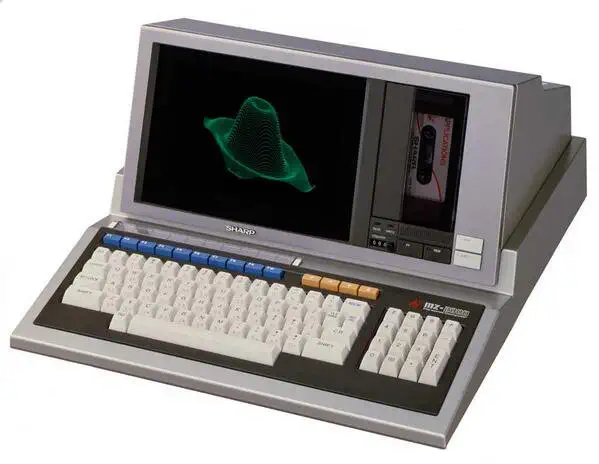The Sharp MZ-2000
The Sharp MZ-2000 is the first in the MZ line where Sharp decided to use the Zilog Z80A processor, rather than their own Z80 compatible CPU. The Z80 is clocked at 3.58MHz improving performance as compared to the earlier MZ models.
Like the other MZ machines the MZ-2000 came with a monitor system, which meant that when you powered it up, you would have to wait for BASIC to load from a cassette tape into RAM, this took about 1 minute. The MZ-2000 had as unique feature that if there was no cassette present at boot-time, the door would open, and the computer would ask the user to put a tape in the player.
Ram was 64KByte and an optional 48KByte of VRAM could be installed to give the machine 640x200 pixel graphics capabilities, or 320x200 in 8 colors.
Zilog Z80 CPU Family
The Z80 quickly became popular in the personal computer market, with many early personal computers, such as the TRS-80 and Sinclair ZX80, using the Z80 as their central processing unit (CPU). It was also widely used in home computers, such as the MSX range, SORD, and the Amstrad CPC, as well as in many arcade games. Additionally, it was also used in other applications such as industrial control systems, and embedded systems. The Z80 was widely used until the mid-1980s, when it was gradually replaced by newer microprocessors such as the Intel 80286 and the Motorola 68000.
The Z80 microprocessor was developed by Zilog, a company founded by Federico Faggin in 1974. The Z80 was released in July 1976, as a successor to the Intel 8080. It was designed to be fully compatible with the 8080, but also included new features such as an improved instruction set, more powerful interrupts, and a more sophisticated memory management system.
The Z80 quickly became popular in the personal computer market, with many early personal computers, such as the TRS-80 and Sinclair ZX80, using the Z80 as their central processing unit (CPU). It was also widely used in home computers, such as the MSX range, SORD, and the Amstrad CPC, as well as in many arcade games. Additionally, it was also used in other applications such as industrial control systems, and embedded systems. The Z80 was widely used until the mid-1980s, when it was gradually replaced by newer microprocessors such as the Intel 80286 and the Motorola 68000. The design was licensed to Synertek and Mostek as well as the European SGS.
The Z80s instruction set is binary compatible with the Intel 8080, so that 8080 code such as the CP/M Operating System and Intel's PL/M compiler for the 8080 can run unmodified on the Z80. The Z80 had many enhancements over the 8080 such as 16-bit data movement instructions, block copy and block I/O instructions, single bit addressing of all registers, IX/IY offset registers, better interrupt system and a complete duplicate register file for context switching during an interrupt.
Source: WikiPedia

VRAM: 48kB
VRAM optional Sound Chip Intel 8253 PIT generating square wave Sound 1 square wave channel. Display Chip PCG - Programmable Character Generator Display 320x200 8 colors640x200 Best Color 8 colors Best Graphics 640x200 Sprites none System OS Monitor System Storage Built in Tape Drive

